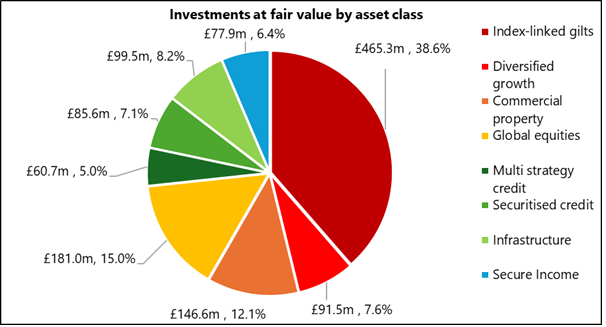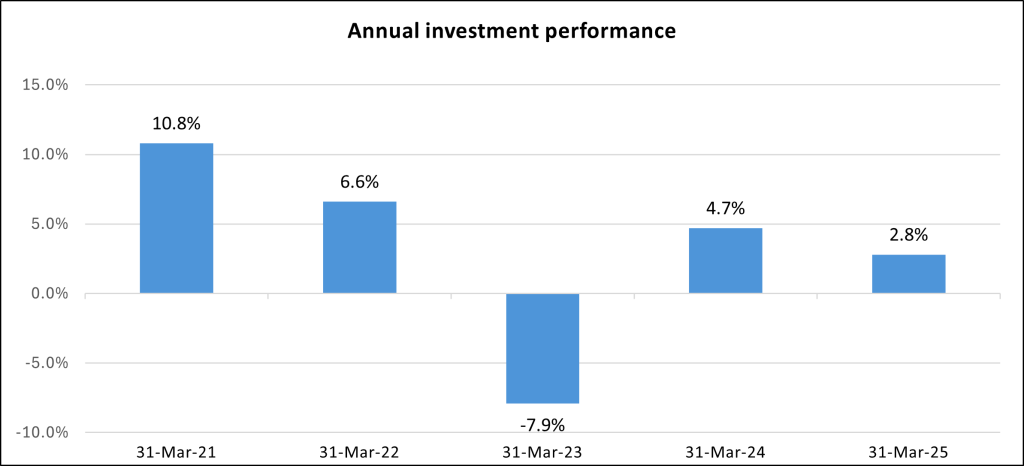
Principal investment objective:
The Trustees’ principal investment objective is to invest the assets of the Trust Fund in such a way as to maximise the likelihood that the returns on the assets (net of tax and costs), will be sufficient to meet the anticipated invoice costs of all pre-paid funeral plans for which funds are held in the Trust.
The Trustees also seek to limit the volatility of the funding position at any given time and this is taken into account when considering the required returns.
Investment strategy:
The Board determines its investment strategy based on the recommendations of the Investment Strategy Group (ISG) and after taking advice from its investment advisers. It has put in place a diversified asset allocation which at the reporting date comprised mandates with nine investment managers to take advantage of investment expertise in different areas.
The Board’s current target is to hold 40% of assets in index-linked gilts, with the other 60% divided between global equities, multi-asset funds, commercial property, infrastructure assets, corporate debt, securitised credit and cash. The asset allocation strategy is designed to ensure that the assets are diversified and of appropriate investment quality.
The allocation by asset class at 31 March 2025 is shown in the chart below.
Investment portfolio:
Protection assets are held to closely match the change in existing plan values and as a contractual inflation linkage. Growth assets aim to provide additional investment return over and above inflation in the long term, without any direct link to inflation in the short term. Real assets are also expected to provide investment outperformance, but with a strong link to inflation and so performance is expected to be positive in real terms.

Investment management:
The Trustees have investment management agreements in place with the investment managers that set out guidelines for the underlying investments held by the funds. The Trustees, with the support of its investment advisers, carry out due diligence in advance of appointment of each of the investment managers and on the operation and governance of each of the funds or mandates, and agree appropriate controls. The Trustees have meetings with each of the investment managers as necessary, usually on an annual basis.
The Trustees have adopted an Environmental, Social, and Governance (“ESG”) policy of oversight. The Trustees have responsibility to ensure that the investment managers’ policies are appropriate to the specific assets they manage. This is achieved by requiring the investment managers to address the issue specifically during the annual review meeting with the ISG.
Investment performance:
The performance of the investment managers is measured against specific benchmarks and monitored by our investment advisers and by the ISG. Each month our investment advisers provide the ISG with a statement of the overall performance of the investment portfolio and of the individual underlying managers. A full report is provided each quarter which is used by the Board in their review of investment performance.
Over the year to 31 March 2025, the overall return on the portfolio was approximately 2.8% with circa £35 million received in cash distributions from the invested assets to assist with cashflow. Over the five-year period from 2020, the average return on the Trust’s investment portfolio was 3.2% per annum and over the ten-year period from 2015, it was 3.9% per annum.

In the 12-month period to 31 March 2025, market focus shifted from inflation, which moved closer to the 2% target over much of the period, to the pace of global interest rate cuts. Towards the end of 2024 inflation rose back to 3% in the UK and US, reflecting the significant global geopolitical uncertainty arising from the US election results. Over the year to 31 March 2025, all major central banks loosened monetary policy in response to falling inflation, with the Bank of England reducing the base rate from 5.25% to 4.50%, the European Central Bank reduced its deposit rate from 4.00% to 2.50%, and the Federal Reserve reducing the Federal Funds Rate range from 5.25%-5.50% to 4.25%-4.50%. Close to target inflation, coupled with strong economic growth in the US and falling interest rates helped global equities to rise by 8.0% over the period. The US market, which makes up approximately 65% of the global index, drove most of these gains.
Overall portfolio performance was positive over the year, driven by strong performance from the growth assets and real assets held by the Trust. The portfolio of index-linked gilts, however, suffered over the period as the negative impact from rising real yields led to a fall in the value of the gilt portfolio. Despite rises in yields, the Trust’s credit assets contributed to the positive performance as credit spreads continued to tighten over the period, reaching historic lows. The growth portfolio’s strong performance was driven by equity market rallies over the course of 2024, which was driven by US technology stocks. However, over the first quarter of 2025, global markets began to focus on rising geopolitical uncertainty as the US president took office and details of his tariff policies emerged. This detracted slightly from the high levels of returns experienced in 2024. The multi-asset holding over the year did not manage to keep up with equity performance, given their more defensive positioning and expectation that market volatility would increase. This positioning, however, benefited the Trust in the first quarter of 2025 as it provided diversification benefits during a period of market turmoil. The Real Asset portfolio performed positively over the year, linked to improved interest rate outlooks following the rate cuts in major economies.
Outlook:
The likelihood and impact of risks to the investment portfolio are considered by the ISG at its quarterly meetings and any agreed actions and additional control measures are taken to the Board for approval. Alongside this our investment advisers are regularly instructed to perform and report on the results of stress testing scenarios.
Over the year, the ongoing appropriateness of the investment strategy is reviewed both at a portfolio and individual mandate level and required changes are made to the strategy and portfolio to respond to emerging or developing risks. The ISG continue to work to ensure the portfolio is positioned to meet its objectives and to be resilient to risks and volatility in so far as is possible now and into the future.
Christine Johnson
Chair of the Investment Strategy Group
30 June 2025